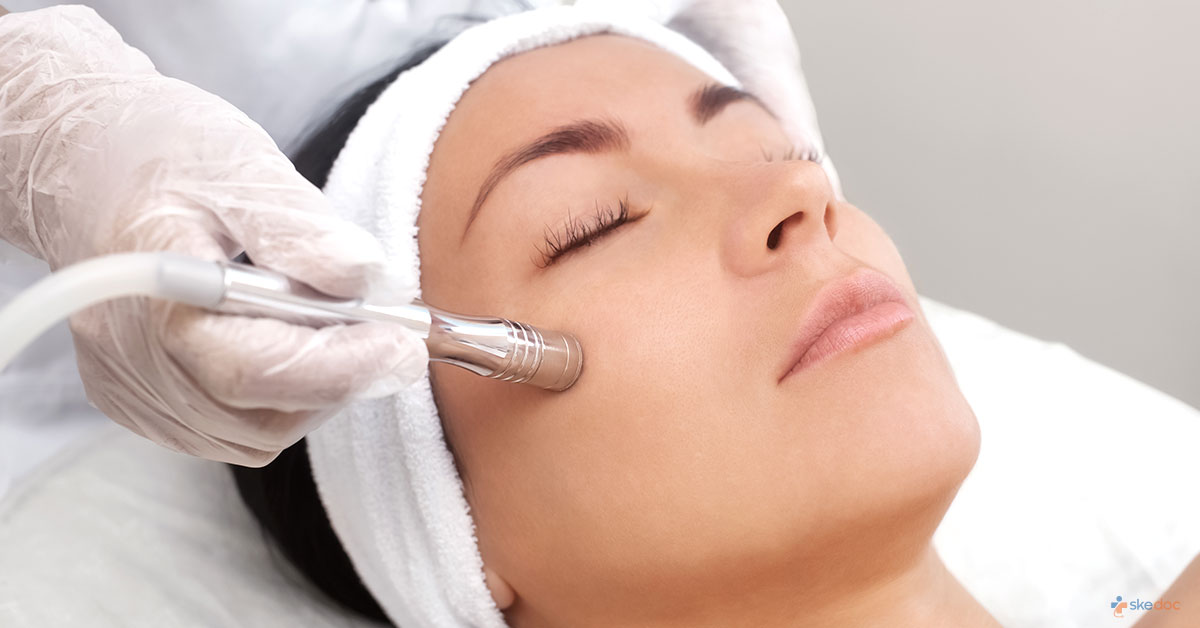Allergy
Blood Diseases
Bone & Joints
Brain
Cancer
Child Care
Cosmetic Surgery
Diabetes
Endocrinology
ENT
Eye
Gen Medicine
General Surgery
Heart
Kidney
Lifestyle
Liver & Digestive
Lung
Men’s Health
Mental health
Physiotherapy
Rheumatology
Skin and hair
Sleep Disorders
Spine
Transplant
Women Health
Thyroid
Vascular Surgery
What to know about Microdermabrasion?

What is Microdermabrasion?
Microdermabrasion is a non-invasive skin resurfacing and rejuvenating procedure that is done to improve the appearance of the skin. Microdermabrasion makes use of exfoliating elements such as crystals or diamond flakes to remove dead skin cells from the outermost layer of the skin. The advantage of microdermabrasion is that it is easy to perform, painless, optimally effective, with minimal complications, and with minimum discomfort to the individual.
Is this procedure an elective or an emergency procedure?
Microdermabrasion is an elective procedure.
What are the types of Microdermabrasion?
Based on the medium used for exfoliation, microdermabrasion may be done using
- Aluminum oxide crystals
- Bristle tips
- Diamond tips
- Magnesium oxide
- Organic grains
- Sodium bicarbonate crystals
- Sodium chloride crystals
- Liquid sprays
Indications
Microdermabrasion is indicated for the management of superficial skin conditions such as the following
- Early photoaging
- Fine lines
- Superficial scarring
- Reduction of pore size
Microdermabrasion causes minimum burns and pigmentary complications in a majority of the skin types as the wound caused due to the procedure is superficial and therefore does not cause deep scarring or pigmentary changes.
Contraindications & Risk Factors
Microdermabrasion is not done if the following are present
- History of radiotherapy to the head
- Use of Isotretinoin – either ongoing or within the past 6 months
- Facial surgery within the past 2 months
- History of hypertrophic scarring anywhere on the body
- Current bacterial or viral skin infections such as impetigo, warts, herpes simplex
- Presence of acne rosacea
- Presence of telangiectasis
Investigations before the procedure
No specific investigations are required before performing a microdermabrasion procedure.
Preoperative Advice
Before performing microdermabrasion, the following are done
- Risks and benefits of the procedure are explained
- A complete medical history is obtained and a history of use of medications such as isotretinoin is ascertained
- Advised to avoid waxing, electrolysis, and laser hair removal 1 week before the procedure
- Advised to avoid sun exposure for up to 2 weeks before the procedure
- Contact lenses are not to be worn during the procedure
Intraoperative Details
Anesthesia: No anesthesia is required for the procedure
Duration: microdermabrasion procedure can last for an hour or so
Details of the procedure: Prior to the start of the microdermabrasion procedure, the skin is cleaned of all makeup and oils, and protective eye gear is worn. The equipment used for the procedure consists of a handpiece with the exfoliative medium along with a vacuum suction device whose pressure is controlled by a foot pedal. The vacuum pump ensures that a high-pressure stream of the exfoliative medium is applied to the skin being treated via the handpiece which is maintained in consistent contact with the skin at the right pressure without causing discomfort to the individual. The dead skin cells are gently sucked and removed via the handpiece and the vacuum pump. The pressure being applied is modified depending on the area of the face being treated; higher pressure is applied on areas such as the forehead, chin, or nose, while lower pressure is applied on the lower eyelids and upper cheek.
Post-Operative Advice
After the procedure is complete, the area is cleaned with a wet cloth to remove any leftover crystals or residue, and once the skin is dry a moisturizer with sunscreen is applied.
Common post-procedure complaints
- Redness of the skin – which usually resolves in a few hours
- Mild burning sensation – which resolves in a few days
- Increased photosensitivity
The procedure is done as an outpatient procedure, and the individual can leave once it is complete.
Medications – advised continuing to apply a moisturizer with sunscreen for a few days after the procedure.
Review: microdermabrasion requires 5-12 sessions for effective results; the number of sessions varies between individuals. Sessions are done once every week for the first few sessions followed by a session every two weeks and finally a session once a month. Maintenance sessions may be required once every 6 months or 12 months.
Complications
Microdermabrasion is a very safe procedure with no complications if all safety protocols are followed. If protective eye gear is not used, there is a risk of corneal congestion and superficial punctate keratopathy due to stray or residual crystals getting into the eye.
Prognosis
The prognosis and results from microdermabrasion are generally very good when treated with superficial skin conditions. The procedure is painless, safe with minimal to zero side effects, and is easy to perform.
When to contact the doctor or hospital for hospitalization if required?
Microdermabrasion is done as an outpatient procedure, and hospitalization is not required.
Suggested clinical specialists/departments to consult for this procedure
Dermatology
Was this article helpful?
YesNo




